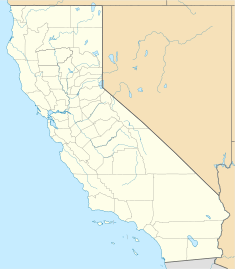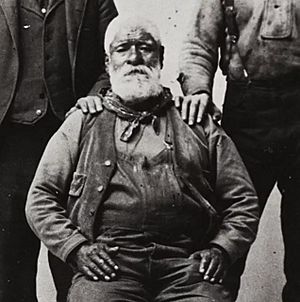Mission San Buenaventura facts for kids

The restored chapel at Mission San Buenaventura in July, 2005
|
|
| Location | 211 East Main street Ventura, California 93001 |
|---|---|
| Coordinates | 34°16′52″N 119°17′53″W / 34.28111°N 119.29806°W |
| Name as founded | La Misión San Buenaventura |
| English translation | St. Bonaventure Mission |
| Patron | St. Bonaventure |
| Nickname(s) | "Mission by the Sea" |
| Founding date | March 31, 1782 |
| Founding priest(s) | Junípero Serra, O.F.M. |
| Founding Order | Ninth |
| Military district | Second |
| Native tribe(s) Spanish name(s) |
Chumash Ventureño |
| Native place name(s) | Mitsqanaqa'n |
| Baptisms | 3,875 |
| Marriages | 1,097 |
| Burials | 3,150 |
| Secularized | 1836 |
| Returned to the Church | 1862 |
| Governing body | Roman Catholic Archdiocese of Los Angeles |
| Current use | Parish church / museum |
| Official name: Mission San Buenaventura and Mission Compound Site | |
| Designated | 1975 |
| Reference no. | #75000496 |
| Reference no. | #310 |
The Mission San Buenaventura is a historic Catholic church in Ventura, California. It was the ninth Spanish mission built in California. A famous leader named Junípero Serra founded it on March 31, 1782. This was the last mission he started during his lifetime.
The mission is named after St. Bonaventure, an important leader of the Franciscan friars in the 1200s. In 2020, Pope Francis gave the church a special title, making it a "minor basilica." This means it's a very important church in the Catholic Church.
The mission was first planned in 1770 but had to wait because there weren't enough soldiers to protect it. The first church building burned down in 1793. Today, only the church and its garden remain from the original mission. It's a special place that teaches us about California's past.
Contents
Founding the Mission: A New Beginning
The story of Mission San Buenaventura began on March 30, 1749. On that day, a Franciscan friar named Junípero Serra decided to travel to the New World. He wanted to become a missionary and help the native people.
Many years later, on March 31, 1782, he finally raised a cross at a beach in Santa Barbara. He held a special church service and dedicated the new mission to St. Bonaventure. This mission was supposed to be the third one built, but it ended up being the ninth. It was also the last mission Serra founded himself.
Building and Growing: Early Years
After the mission was founded, Friar Pedro Benito Cambon took charge. Between 1805 and 1815, the local Chumash people helped build a system of aqueducts. These were like ancient water pipes, made of ditches and stone walls. They brought water from the Ventura River to the mission's holding tanks, about 7 miles away.
With plenty of water, the mission grew beautiful orchards and gardens. An English explorer named George Vancouver said they were the best he had ever seen. Sadly, floods damaged the aqueduct system in 1862, and it was no longer used.
The mission's first church building was destroyed by fire in 1793. They tried to build a second church, but it didn't work out. A strong, permanent church wasn't finished until 1812. Around this time, two smaller chapels, San Miguel and Santa Gertrudis, were also completed.
Facing Challenges: Earthquakes and Pirates
In 1812, a series of earthquakes and a huge seismic sea wave (like a tsunami) hit the area. The friars and the native people had to move inland for safety. Six years later, in 1818, they faced another danger. An Argentine pirate named Hippolyte de Bouchard was attacking missions along the coast. The mission had to hide its valuable items and flee into the hills to escape him.
Changes Under Mexican Rule
After Mexico became independent from Spain, the Mexican government made a big change in 1834. They decided to take control of the missions away from the friars. This process was called "secularization." In 1845, Mission San Buenaventura was rented out and later sold, though this sale was not legal.
The mission also felt the effects of the Mexican–American War (1846–1847). In 1847, American soldiers, led by John C. Fremont, passed by the mission. They had a small fight with some local Californians nearby.
Becoming Part of the United States
When California joined the United States, the Catholic Church wanted its mission lands back. In 1850, the first Catholic Bishop of Monterey asked the U.S. government to return the church, priest's home, cemetery, orchard, and vineyard. President Abraham Lincoln agreed, and the land was returned to the Church on May 23, 1862.
An earthquake in 1857 badly damaged the mission's tile roof, so it was replaced with shingles. In 1893, a priest named Cyprian Rubio "modernized" the church's inside. He painted over old artwork and changed many things. The windows were made longer, and the original ceiling and floor were covered up. Parts of the old mission buildings were torn down. A school was planned but not built until 1921. Later, under Father Patrick Grogan, the roof was tiled again, and new buildings were added.
Education and Restoration Efforts
Children have been educated at Mission San Buenaventura since 1829, even during Mexican rule. The Holy Cross School has been teaching students continuously since 1922. It started with four classrooms and grew over the years.
Major restoration work happened in 1956–1957. During this time, the windows were put back to their original size. The old ceiling and floor were uncovered, bringing back some of the church's original look. A new bell was added to the bell tower, joining the four old ones.
In 1976, the entire roof of the church was replaced. Later that year, the church was officially blessed by Cardinal Timothy Manning. The mission celebrated its 200th birthday in 1982. A new three-story school building opened in 2001, located behind the mission. This building also has a chapel, classrooms, a kitchen, and a large hall for school and church events. The mission celebrated its 225th anniversary with many events in 2006–2007.
Today, the main church building and its peaceful garden are all that remain of the original mission complex. Inside the mission, there's a small museum. It displays interesting items from the Chumash people and the mission era.
Mission San Buenaventura is special because it's still in the heart of downtown Ventura. Unlike many other missions, the city's main area grew up right around it. The church is still an active parish today, serving about 2,000 families. Church services are held regularly. In 2024, a statue of Father Serra, which used to be in front of the Ventura City Hall, was moved to the mission garden.
Other Important Historical Sites Nearby
- National Register of Historic Places – The Mission San Buenaventura Aqueduct is recognized as a historic place.
- California Historical Landmark – The spot where Junípero Serra first put up a cross, known as La Loma de la Cruz (Hill of the Cross), is in Grant Park.
- California Historical Landmark – The Old Mission Reservoir, which was part of the mission's water system, can be found in Eastwood Park.
- California Historical Landmark – More parts of the San Buenaventura Mission Aqueduct can be seen on Cañada Larga Road. These are two sections of stone and mortar walls, each about 100 feet long.
Mission Life: Animals and Crops
Animals were very important at Mission San Buenaventura. They had cattle, horses, sheep, donkeys, and goats. Cattle were especially useful because they provided food, oil, and hides. In 1818, over 35,000 cattle roamed the mission lands. By 1831, the number of animals had decreased, but they still had thousands of cattle, sheep, and horses.
The soil around the mission was very good for farming. The mission grew many different crops, including apples, grapes, bananas, pears, plums, pomegranates, figs, oranges, coconuts, beans, grain, corn, and barley. In 1818, they harvested over 12,000 bushels of grain. Even after some changes in 1831, they still harvested thousands of bushels of wheat, barley, corn, and beans.
The Mission Bells
Bells played a huge role in daily life at Mission San Buenaventura. They rang to call people to church, to meals, and to work. The mission had five bells. Some of these bells were borrowed from Mission Santa Barbara and were never returned.
One bell faces north and says S. San Francisco 1781. Another bell faces east and says San Pedro Alcantra 1781. A smaller bell in the southern arch says Ave Maria S. Joseph. The largest bell, which is still used every day, has a crown on top and a cross on its side. It says Ave Maria Pruysyma D Sapoyan Ano D 1825, which means "Hail Mary Most Pure. Mary of Zapopan Year of 1825." This bell was originally made for a church in Mexico. There are also two unique wooden bells in the museum, about two feet tall. These are the only wooden bells found in the California missions.
Gallery
-
Bell marking the El Camino Real
See also
 In Spanish: Misión San Buenaventura para niños
In Spanish: Misión San Buenaventura para niños
- Spanish missions in California
- List of Spanish missions in California
- List of Catholic basilicas
- San Buenaventura Mission Aqueduct – This aqueduct brought water to the mission.
- San Miguel Chapel Site – The location of an early outpost for the mission.
- USNS Mission Buenaventura (AO-111) – A ship named after the mission.
- City of Ventura Historic Landmarks and Districts










